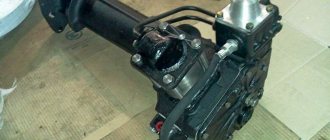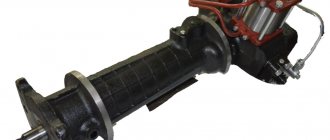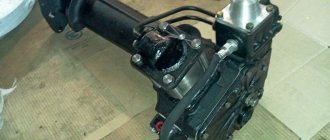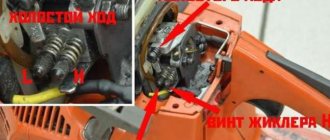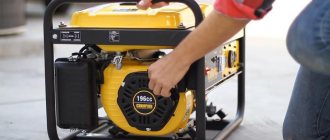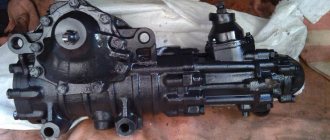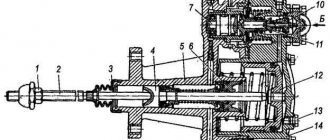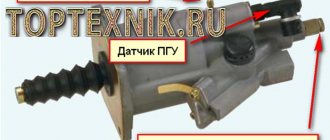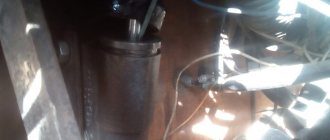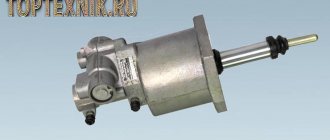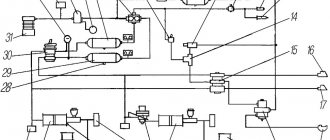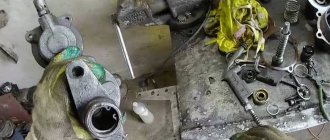Hydraulic power steering (power steering) has some advantages over all others, which is why they are still used today, despite the obvious progress in the field of electric servos. But they require more attention during operation, which is primarily due to the use of a liquid hydraulic agent - special oil and everything connected with it.
Why do you need power steering?
The power steering system is part of the steering system. It is designed to reduce the effort that the driver needs to make to change direction. Additionally, the system transmits the condition of movement of the rotary wheels to the steering wheel (among motorists, “road sense”). It also takes on the load from wheel impacts without transferring it to the steering wheel.
Modern control systems are equipped with a combined type hydraulic booster. That is, it refers to the overall design of the vehicle control mechanism. Thanks to this, the car can be driven even if the power steering fails, but in this case the load on the steering wheel will increase significantly.
Causes and consequences of oil foaming in the hydraulic booster
Power steering is one of the additional devices of the car system, which makes driving easier and more comfortable. Like any technical component, the hydraulic booster is capable of breaking, and the problems associated with it are specific and can be very dangerous. In this article we will take a closer look at the reasons why power steering oil foams and how to solve this problem. Most car owners do not pay due attention to this malfunction, and it is in vain, because because of it you may find yourself in mortal danger.
Many motorists can no longer imagine driving a car without power steering.
Advantages and disadvantages of power steering
In most cases, having sophisticated equipment brings both its pros and cons. The power steering was no exception.
Advantages:
- softening shocks and impacts from wheels when driving;
- reducing the number of turns of the steering wheel when performing a maneuver;
- reducing the effort required to turn the steering wheel.
Flaws:
- increased fuel consumption - any additional mechanism powered by the engine will additionally consume fuel;
- drop in power of the power plant - part of the energy is spent on operating the power steering pump;
- The hydraulic booster is not controlled by the ECU.
Liquid leakage, where to look and how to fix it
Let's move directly to the technical part. So, the force on the steering wheel when driving has increased significantly. The most common cause of this phenomenon is the loss of fluid from the system.
There are not so many reasons for this phenomenon: damage or leakage of the system tank, possible weakening of the fastening of pipelines at the entrances to the components of the system, breakdown of the pipelines themselves.
These faults are easy to detect; just carefully inspect all pipelines and fastening elements for leaks.
If a leak is detected, it can be eliminated by tightening or replacing the damaged pipeline.
But that’s not the only place where a leak can form. It is much worse if the leak occurs due to worn rubber products included in the design of the pump or distributor.
It is more difficult to eliminate these leaks due to the need to remove the power steering units from the car and carry out repair work with the replacement of damaged elements.
Power steering operating principle
The power steering includes several main elements, these include the following:
- pump;
- expansion tank;
- highways;
- spool valve;
- two cylindrical cavities inside the rail.
The operation of the hydraulic booster is based on creating an area of high pressure. Using a pump, oil is taken from the tank and pumped into the line. When the steering wheel is turned, depending on the direction, the spool valve directs the fluid flow to one or another cylinder.
The pressure exerted on the piston inside the rack creates additional force. This helps move the rod in the desired direction, reducing the force required to turn the steering wheel.
The oil in the system is intended not only to lubricate and protect parts, but also to transmit energy. Its condition has a significant impact on the operating efficiency and service life of the mechanisms.
Operating principles of MAZ power steering spare parts.
• Parts of the steering linkage;
While the car is moving, force is applied to the steering wheel to turn the car. However, when turning, the car's shaft also rotates. Thus, the steering mechanism is activated, which turns the bipod. Then the longitudinal rod connected to the hydraulic booster moves. The force from this spare part is gradually transferred to the lever, which subsequently turns the axle of the left wheel (front). At the same time, the right wheel turns due to the operation of the lower lever.
In addition to reducing the effort when turning the steering wheel, the MAZ power steering, part number 503A-3405010, also serves to absorb shocks to the steering wheel transmitted while the car is moving from the road. It also improves driver safety, since even if the front tires break, it maintains vehicle controllability.
Correct operation of spare parts power steering MAZ.
If you are interested in the long service life of this spare part, follow a few simple rules:
• Monitor the oil level;
• Change both the oil in the system and the oil filters twice a year. If the color of the oil changes before the replacement date, we recommend replacing it;
• If the MAZ hydraulic booster malfunctions or there is an oil leak, immediately inspect the vehicle;
• Monitor the tension of the drive belt. Make adjustments as necessary.
As a rule, if the MAZ power steering spare part is used correctly, vehicle breakdowns will not occur. However, if you encounter any malfunctions, we recommend that you inspect it carefully.
If the car behaves strangely on the road, for example, if normal movement requires constant alignment of the car using the steering wheel, check the steering wheel. If the free play is too high, adjust it. We also advise you to monitor the condition of the screw pairs.
If they are worn out, replace them immediately. However, if even after all the replacements the car is unstable on the road, pay attention to the reaction plungers, which are located in the housing of the control valve, spool valve. If a part gets stuck, wash it.
Damage to the spare part may also occur due to a clogged filter. Therefore, if you find foam in the tank or cloudy oil, replace the filter and flush the entire system. Don't forget to look at the manifold gasket. If worn, replace parts.
Why do you need to bleed your power steering?
Despite the large number of advantages, the system also has disadvantages, and the main one is breathability. But for normal operation, it should not have water, air, dust and dirt in the lines.
Improper car care can cause a number of problems that will lead to:
- rapid wear of mechanisms, as a result of which a lot of metal chips get into the working fluid;
- destruction and failure of rubber parts, resulting in loss of tightness;
- changes in oil composition under the influence of high temperature;
- destruction of hoses and pipes.
All this leads to gradual depressurization of the power steering system. And this is a very dangerous situation, because it can lead to the following consequences:
- complete change in the technical properties of the drive;
- steering wheel locks in one position and complete loss of vehicle control;
- uneven rotation of the steering wheel, which greatly complicates maneuvers.
Important! Bleeding the hydraulic booster is a very important and responsible event that guarantees stable operation of the control system. That is why the procedures must be performed by a person competent in this matter.
In order for the power steering to effectively fulfill its purpose, experts advise using only high-quality oil recommended by the vehicle manufacturer. And also carry out pumping in a timely manner, following the instructions, if necessary, replace the working composition completely and monitor the condition of the steering rack boot.
Purpose and design features
Power steering is designed not only to make it easier for the driver to control the car when maneuvering on the road, but also to soften impacts from bumps and damaged road surfaces
It is especially important that the hydraulic booster significantly reduces the likelihood of an accident when a tire breaks, primarily on the front wheels
Power steering is a closed hydraulic system, which includes:
- a tank into which hydraulic fluid is filled;
- pressure regulator;
- control spool;
- pump;
- power cylinder.
The main unit of the hydraulic booster design is the pump. It ensures the pumping of liquid from the tank into pipelines and its further movement under high pressure along the ring. The type of mechanisms used is gate or plate units. They have a sufficient level of efficiency and little wear on the working surfaces. At the same time, they have a weak link; the bearing may fail, which requires repair of the power steering pump.
The operating pressure in pumps of this type, intended for the power steering system, is high, up to a maximum of 150 bar. Such a unit is driven by a belt that simultaneously turns the generator and the pump.
The gaps that are set at the factory during assembly must be maintained in the range of 0.005-0.01 mm. If the gap increases and exceeds the permissible value by 0.01 mm, then a drop in pressure in the system at low speeds is possible; this is felt on the steering wheel as an increase in load, or in the language of professionals - a “tight” steering wheel.
Signs of a malfunction in the power steering
- airing of the system and the need to rock it will be indicated by some symptoms, including the following:
- there is a strong noise in the area of the power steering or pump;
- the pressure on the steering wheel has increased, which makes driving difficult;
- working fluid is leaking from lines or components;
- foam appeared on the surface of the composition in the expansion tank;
- the wheels spontaneously turn in one direction.
If at least one of the listed signs appears, it is necessary to immediately bleed the power steering.
Typical power steering faults
You can find out which particular node or element has failed by the corresponding signs.
- The steering wheel turns tightly - most likely the power steering pump has failed, the wrong hydraulic fluid has been filled in, or the channels of the spool valve are stuck.
- While driving, when you turn the steering wheel all the way, no matter in which direction, a high-frequency sound similar to a whistle appears - the drive belt is loose.
- The steering wheel turns jerkily - the characteristics of the working fluid do not correspond to the required ones, there is a malfunction in the distribution valve, the pump has failed.
- Foam has appeared in the expansion tank - different types of liquids are mixed, the pump is faulty.
- While the engine is running, the steering wheel turns spontaneously - a malfunction of the distribution valve. More often this can be caused by clogged channels or incorrect assembly after repair.
In addition, when driving on a flat road, you periodically need to level the car by moving the steering wheel. This could be due to two reasons. The first is the presence of free play; if it exceeds the permissible threshold, adjustment will be required. Secondly, the elements of the steering gear screw pair are worn out, in which case they will need to be replaced.
Checking the power steering for airiness
If you suspect that the power steering system is airy, but there are no obvious signs of this, you can conduct testing. It is performed in the following sequence:
- Start the engine and warm it up to operating temperature. You can leave it idling for 30 minutes or drive it on the highway for 20 minutes.
- Then come back and, without stopping the engine, turn the steering wheel in any direction about 15 times.
- Now turn off the engine and open the hood.
- Check the condition of the working fluid in the expansion tank.
If there are bubbles, it means air has entered the power steering system and requires bleeding. Before you begin, review the technical documentation for your car and check which method is suitable in your case. Although there is a general procedure, some cars have their own characteristics, so manufacturers may provide recommendations to avoid damage to the power steering.
Reasons for air entry
In most cases, air enters the hydraulic system at the moment when car maintenance activities are carried out. For example, when replacing fluid in a hydraulic system. To avoid airiness, experts advise pouring the mixture at a rate of approximately 5.5–6 l/min.
If foam or bubbles form in the distribution tank during replacement, then you need to let the liquid sit for at least 20–30 minutes so that the air is completely released. Another common cause of air ingress is wear and tear of high-pressure pipes. To remove air from the power steering in such a situation, it is necessary to completely replace the unsuitable elements.
How to pump power steering
Work on pumping and replacing the working fluid must be carried out in strict sequence. But, as mentioned above, some automakers may make their own additions. In general terms, the algorithm of actions looks like this:
- The car is lifted on a lift or the front wheels are hung out.
- If necessary, the old fluid is completely drained from the expansion tank. To do this, remove the return hose from the container and plug it so that the mixture does not leak out. A tube is installed on the vacated valve, leading to an empty container (bottle or jar), into which the used hydraulic fluid will be drained.
Note: it is easier to pump out the bulk of the hydraulic fluid using a syringe with a tube into a separate container. Residues are removed using the method described above.
- Fresh hydraulic composition is poured into the expansion tank to the top.
- Now you need to turn the steering wheel from lock to lock. This is done so that the remaining old fluid flows out through the disconnected hose. At this point, you need to monitor its level in the tank and, if necessary, top it up so that the system does not trap air.
- The engine starts for a few seconds and immediately stops. This is necessary for faster distribution of liquid through the pipes.
Important! An airy power steering system can be bled by rotating the steering wheel from one side to the other. But under no circumstances start the engine. Air entering the system is critical for the power steering pump and can lead to its failure.
- The working fluid is added to the tank up to the MAX mark and the procedure for starting the engine is repeated. Sometimes up to 3-5 repetitions are required.
- The signal that pumping is complete is the moment when air stops escaping into the drain container through the return hose. This indicates that the system is no longer aired, and only fresh, clean composition comes from the expansion tank.
- After this, the return hose is attached back to its place.
- Check the fullness of the power steering reservoir again, if necessary, add fluid to the MAX mark and start the engine.
To fully pump the power steering, it is enough to slowly turn the steering wheel from right to left 4-5 times. Pause at the points of emphasis for a few seconds. If there are any air bubbles left in the pipes, after such actions they will escape into the expansion tank. When pumping, you need to make sure that no sounds atypical for its operation are heard from the pump.
The complete completion of pumping can be judged by the absence of air bubbles on the surface of the liquid. Now it's time to close the expansion tank cap and hood.
You can also bleed the power steering “on a cold” basis without starting the engine. To do this, you need to turn the steering wheel from right to left from lock to lock. At this moment, the waste liquid and air, as with the usual method, will exit through the disconnected return hose. But most manufacturers recommend bleeding with the engine running.
Do not allow the hydraulic fluid level to drop below the MIN mark. Also remember that during heating the composition will begin to expand, so do not allow it to overflow more than MAX.
Types of power steering fluids
All products can be broadly divided into mineral and synthetic. The second involves deeper processing of the source material, which entails a significant improvement in beneficial properties.
There are many directions for such improvement, the quality is constantly growing, developing according to different properties. This has led to the specialization of mechanical components; they are initially sharpened for certain types of oil, so the correct choice becomes of particular importance.
Oil requirements
Power steering oil performs a number of functions:
- hydraulic, that is, directly related to the transfer of energy from the pump to the actuator;
- lubricating, the product must ensure a minimum of friction losses and reduce wear to zero on surfaces covered with an oil film;
- cooling, heat transfer from working parts is carried out through the same agent;
- protective, corrosion of various metals used, as well as degradation of stuffing box and gasket seals is unacceptable;
- ensuring its own stability of properties, that is, the oil must always have fixed properties, not change viscosity, not foam, not allow cavitation, not decompose due to temperature and not require replacement for a long time.
If a mechanism is designed for a certain type of oil, then the use of another, even more suitable for other devices, will either worsen the power steering characteristics or lead to rapid wear and breakdown.
Color
The division of oils by color is largely arbitrary and is done mainly to eliminate gross errors in selection.
Three color codings can be roughly distinguished.
- Red ones are the most common, which is due to the compatibility of requirements with ATF type gear oils. They can be mineral and synthetic, which is important to know; these products have sharply different lubricating properties and dependence of viscosity on temperature. Moreover, it is not at all necessary that an outdated one can be replaced with a more advanced type. The power steering will not be able to work correctly in this case.
- Yellow , of German origin based on a set of characteristics. They are considered specialized, that is, not unified with ATF. For specialty oils, the abbreviation PSF is used.
- Green ones are specific liquids for which the amplifier must be strictly designed. Mixing with others is highly undesirable. In some cases, a complete replacement with flushing is acceptable.
In any option, you need to focus on the specifications of the car manufacturer; color will not help you make the right decision.
Viscosity
More viscous oils have better lubricating properties, but in the case of power steering this is far from the most important thing. Much more important is the temperature stability of this parameter. With synthetics, this requirement is easier to fulfill.
This is interesting: How to replace the fluid, how to flush the power steering and when it should be done
In addition, pumpability at low temperatures is easier to ensure, which helps protect the mechanism from breakdowns in extreme cold.
There are fewer problems with overheating, but for those who like to overload the power steering by fast steering in the heat or holding the steering wheel in extreme positions, problems can arise either over time or suddenly. It is better to use expensive synthetics with a large margin in the operating range.
Bleeding using a special kit
This method is suitable for bleeding power steering of later car models, but it can be used on any vehicle. The method involves the use of a vacuum pump, with which you can pull out an air lock of any complexity without damaging the seals. In addition, using a special pumping kit significantly speeds up the process.
To carry out the work, you will need to take a vacuum pump and a kit for purging the power steering system. The execution procedure looks like this:
- The car is installed on a flat surface.
- We wait for the engine to cool completely and open the hood.
- Remove the cover and install the adapter for the vacuum pump in its place.
- We connect the device to the air vent.
- Start the engine.
- Using a pump, we create a vacuum of 20 inches (508 mm) of mercury.
- We wait 5 minutes and check whether the discharge indicator has dropped. This is necessary to ensure the integrity of the system. If the arrow gradually moves, this is not a big deal, but if the readings change quickly, you can judge that the system is depressurizing. This means that air can be sucked in through the hole while driving.
- If your car has power brakes, be sure to press this pedal several times as well.
- Smoothly turn the steering wheel from side to side 10 times without pressing the stops.
- We align the wheels in the center and turn off the engine.
- Remove the pump and adapter to bleed the system.
If there are air bubbles on the surface, you need to wait about 5 minutes. During this time they should completely disappear. Now the working fluid level is checked, it should be at the MAX level. Top up if necessary.
After this, replace the cover with a vacuum pump again and repeat the procedure from the beginning. The complete absence of bubbles will signal completion. In this case, a cap is screwed onto the expansion tank, and the system is checked for leaks.
Bleeding GM power steering or systems on Honda
To bleed the power steering system from General Motors, you must follow a certain procedure. Basically, the only difference is that you will be required to turn off the engine when bleeding the power steering. This way you will protect the pump and its elements from accidental interaction with air, which can damage the part.
Power steering pumping is performed in the following sequence:
- Place the car on a level surface and wait until the engine cools down completely.
- Turn the steering wheel all the way to the left for General Motors or right for HONDA.
- Open the power steering expansion tank cap and check the fluid level. If necessary, add it to the required level.
- Now you need to hang the front wheels. You can use a jack for this.
- Smoothly turn the steering wheel from side to side until it stops about 20 times.
Important! If the system has a long return hose, the number of steering turns must be increased to 40 times.
Monitor the fluid level at this moment or ask an assistant to do this. If necessary, add the composition and wipe away any spills. As air is removed from the system, the fluid level will gradually drop. If this does not happen, then the line or pump may be clogged or clogged with an air lock. If you cannot break through the plug by turning the steering wheel, try using a vacuum pump.
A change in the color of the hydraulic fluid to milky white (sometimes yellowish) or the appearance of a large number of bubbles in it indicates depressurization. It is necessary to find and eliminate the place of air intake, and then carry out a check.
On General Motors models:
- Start the engine and leave it idling. If necessary, add fluid to the expansion tank.
- Within 2-3 minutes, smoothly turn the steering wheel from side to side.
Then check the following:
- turning the wheels - they should move smoothly and without jerking;
- level and condition of the fluid - the presence of foam and bubbles indicates depressurization, the same applies to a gradually decreasing amount of hydraulic fluid;
- presence of extraneous noise from the power steering system - there should be no atypical sounds.
If everything is fine, you can turn off the engine and tighten the cap of the expansion tank. This completes the pumping.
On Honda models:
- The first step is to turn off the fuel system, this will prevent the engine from starting. Remove the fuel pump fuse.
- Ask an assistant to monitor the level of working fluid in the expansion tank and crank the engine with the starter for 5-10 seconds.
If at this moment the level drops, then there is air left in the power steering. In this case, you need to repeat the pumping procedure. If foam or bubbles appear, wait 10 minutes and repeat the test procedure again.
Important! There should be at least 5 minutes between turns of the ignition key. This precaution will prevent damage to the starter.
- When no foam or bubbles are visible on the surface of the hydraulic fluid, the system can be considered pumped. Replace the fuel pump fuse and start the engine.
- Check again that there are no air bubbles in the working fluid.
- Close the expansion tank cap and turn off the engine.
- Center the wheels and lower the car to the ground.
- Start the engine again and let it run for 2-3 minutes at idle speed while turning the steering wheel from side to side from lock to lock.
Then, as in the previous case, you need to check the following:
- turning the wheels - the mechanism should turn smoothly and without jerking;
- liquid level - if the level has dropped, foam has appeared or the color of the liquid has changed, the system must be re-checked for the presence of air;
- sound when the engine is running - there should be no atypical noise from the power steering.
If everything is fine, you can turn off the engine. This completes the pumping. Before starting work, it is recommended to check the technical documentation for your car brand. Although there is a standard pumping procedure, each vehicle may have its own characteristics, which are indicated in the technical passport.
MAZ 5549 Lobasty › Logbook › Steering from Super-MAZ (part 1)
Hi all. The winter passed in hibernation, so there was actually no news.
But now it’s getting warmer, the season is just around the corner, so it’s time to start preparing. As I have mentioned several times, my car had very heavy steering. What I didn’t do - I changed the power steering assembly, and adjusted the steering mechanism, and installed a new steering gear, and replaced all the hoses and tubes with new ones - it didn’t give much results. I just spent time, effort and money. In general, I'm tired of it. I decided to install the entire steering system from Super-MAZ. On occasion, a set from a fresh long-range MAZ (5440A9) produced in 2012 was purchased.
— Steering mechanism with distributor (64221-3400010-10) — Power cylinder (5336-3405005-20) — Brackets for fastening to the frame (5336-3403190 and 5440-3403016) — Reservoir (5336-3410010) — Hoses — Longitudinal steering rod ( 5440-3003010) — Upper arm of the axle (5440-3001035)
True, it turns out later that many of them will not fit and will be replaced with other parts
. But everything is in order.
He brought it, unloaded it, and, having disconnected all the steering elements and washed them from the compressor, began to examine them first. I came to the conclusion that the sector shaft and, accordingly, the steering bipod point in the opposite direction - towards the frame.
To install on 5549, you need to swap the covers and move the bipod to the other side, and then adjust the engagement in the pair. Having unscrewed the bolts, removed the covers, and removed the eccentric washers with bearings, I freed the sector shaft. Having turned it at a slight angle, I pulled it out of the steering gear housing.
After washing all the parts, I began to assemble. Before this, I rotated the racks by the shaft from one extreme position to the other, counting the revolutions of the shaft. Found the middle. I installed the sector shaft so that the middle tooth of the sector fell into the middle cavity of the rack nut. Next, I assembled everything in reverse order and adjusted the engagement using eccentric washers. (turning them to the same angle).
To avoid having to do all these operations, it is better to take the steering mechanism under number 64229-3400010-30. With him everything is already looking in the right direction, the direction we need.
Having turned the bipod shaft over, it became clear that the bipod, rod and bracket with 5440 would not fit. Therefore, a bipod from MAZ-5432 was purchased. (No. 64221-3401090) The bracket for fastening the steering mechanism to the frame (No. 5336-3403016) and mounting bolts were taken from the same car.
Then I started working on the power cylinder.
The tip did not inspire confidence, so they were removed and rebuilt. All new inserts, fingers, rubber bands have been installed.
The NSh-32 pump assembly with bracket, pulleys and flow and pressure valve was purchased a long time ago and was waiting in the wings in the garage. Belts 14*10*987 were also purchased
All that remains is to find a suitable longitudinal rod (and not make a mistake, otherwise there are 6 types of them and they all differ in length) and it will be possible to begin the conversion. Don't switch.
Is it worth doing pumping yourself?
It all depends on your experience in carrying out such work, capabilities, and desire to save money. The price of hydraulic fluid is influenced by many factors; it can vary from 300 to 1200 rubles per liter. To pump the power steering system and completely replace the technical mixture, you will need from 1 to 3 liters.
At a car service center, a car mechanic will charge 1,000 rubles to remove air from the lines. To replace the fluid you will have to pay from 2000 rubles. The answer to the question of whether it’s worth upgrading the power steering yourself is entirely up to you.
The procedure cannot be called too complicated. Many novice car enthusiasts with “straight” hands pump up power steering without any problems. The main thing is to strictly adhere to the recommendations, sequence of actions and use only high-quality fluid that is suitable for your power steering model.
Bleeding the power steering system
06/02/2017 Author: Master Service 13894
The power steering system is sealed - air, moisture, and dust should not enter it. Only in this case does the hydraulic fluid effectively cope with its functions: transfers the necessary pressure to the piston, lubricates the system elements, and removes heat.
The power steering system wears out over time even without external influence. Especially if the owner is careless about car maintenance. As a result:
- parts of the elements are destroyed, and microparticles of metal dust enter the liquid;
- rubber parts wear out - the tightness of the system is compromised, and the steering rack repair kit may need to be replaced;
- under the influence of high temperature, chemical reactions occur that change the properties of the oil;
- Hoses and pipes are torn.
Structure of the power steering system
All this eventually leads to depressurization - airing - of the system. In addition, air gets into the power steering if the oil is changed without following the technology.
The solution to this problem is to bleed the power steering system.
Several recommendations for further use
The procedure for bleeding the power steering will help restore the controllability of your vehicle. But to maintain results for as long as possible, you must adhere to several rules:
- fill only with high-quality hydraulic fluid from trusted brands recommended by your car manufacturer;
- carry out timely replacement (every 60-120 thousand km) of hydraulic fluid in the power steering system;
- during pumping, strictly follow the sequence of actions;
- Monitor the condition and operation of the steering rack boot, promptly clean it from dust and other contaminants.
Bleeding the power steering is a very important procedure, which is necessary to maintain the vehicle and all its systems in normal operating condition. Neglecting it can lead to various control problems requiring expensive repairs and even an accident.
see also
Characteristics of Dextron 2 and 3 - what are the differences
- 49 1 35k
Power steering malfunctions
- 30 0 41k
What kind of oil to fill in power steering
- 168 3 223k
Power steering buzzes
- 375 7 351k
15 best power steering fluids
- 126 13 382k
Bleeding the power steering and its system is carried out when replacing the working fluid, airing, which may be the result of a malfunction or repair work. Air trapped inside not only reduces the efficiency of the power steering, but can also cause serious damage, in particular, failure of the power steering pump. Therefore, pumping the hydraulic booster must be carried out in strict accordance with existing technology.
